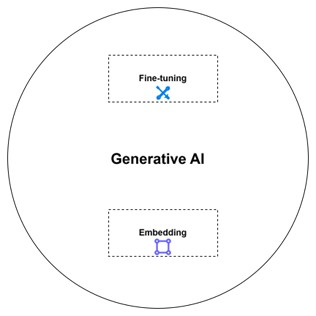3 ways to stay a step ahead in the AI race
How can you stay a step ahead in the AI race? That's a great question, and there's no single definitive answer. In my opinion, the best approach is to commit to continuous learning and remain open to new information. What do I mean by that? Well, many people tend to compare the current generative AI transformation to previous tech revolutions, but that might not be the most accurate way to view it. Why? Because the rate of advancement in generative AI is exponentially faster than anything we've seen before. We're talking about hundreds of billions of dollars invested by the world's leading tech companies, with the brightest minds in AI working tirelessly to enhance its reliability and even surpass human intelligence (e.g. SSI inc. by Ilya Sutskever).
By the way, Generative AI, while a subset of artificial intelligence, is advancing at a rate greater than exponential. Throughout the last few years, it has progressed much faster than the whole field of AI has in the last few decades.

You're probably thinking, 'Okay, I get it, things are changing rapidly, but what can I do about it? Is AI going to replace us all? My stress levels are already high enough...' Well, I didn't intend to cause you any anxiety, but I did want to grab your attention. Now that I have it, let's explore how we can leverage these technologies to our advantage. First, we need to grasp some fundamental generative AI concepts.

1. Prompt Engineering
Imagine you walk into a fancy restaurant. You don't just grunt and point at the menu, right? You use your words to tell the waiter exactly what you want. Prompt engineering is kinda like that, but instead of a waiter, you're talking to a super-smart AI.
It's all about crafting the perfect instructions (prompts) to get the gen AI to do what you want. Think of it as giving the AI a detailed recipe:
- Ingredients: These are the keywords and concepts you include in your prompt.
- Instructions: This is how you structure your request, telling the AI what kind of output you want (a story, a poem, code, etc.).
- Seasoning: This is where you get specific, adding details and constraints to get the flavor just right.
The better your prompt, the tastier the AI's output.
Example: Let's say you want the AI to write a short story about a cat who goes on an adventure. A bad prompt might be: "Cat story."
A good prompt would be: "Write a short story about a fluffy Persian cat named Mittens who escapes his apartment and explores the bustling city streets, encountering friendly pigeons and a grumpy bulldog along the way."
2. Fine-tuning
Alright, buckle up buttercup, because we're about to go from "talking the talk" to "walking the walk" with Fine-tuning!
Remember how we talked about giving the AI a recipe with prompt engineering? Well, fine-tuning is like sending the AI to culinary school!
Instead of just giving instructions, you're actually teaching the AI to be a better chef. You're giving it a whole bunch of new ingredients and recipes (data) to learn from, so it can cook up even more delicious dishes (outputs).
Think of it like this:
Imagine you have a friend who's a pretty good cook, but they only know how to make basic pasta dishes. You want them to learn how to make amazing Thai food. So, what do you do? You give them a cookbook full of Thai recipes and let them practice, practice, practice.
Fine-tuning is kinda like that cookbook. You're feeding the AI a specialized dataset to train it on, so it can become an expert in a specific area.
Example:
Let's say you want an AI that can write really awesome fantasy stories. You could fine-tune it on a dataset of:
- Classic fantasy novels
- Role-playing game lore
- Mythology and folklore
The AI would then learn the patterns, language, and tropes of fantasy writing,
3. Embedding and Retrieval Augmented Generation
Okay, now we're getting into the really cool stuff :) Get ready to have your mind blown by Embedding and Retrieval Augmented Generation (we'll call it RAG for short, because even I get tired of saying that mouthful).
Remember how we talked about fine-tuning being like sending the AI to culinary school? Well, RAG is like giving the AI access to the entire internet's worth of recipes!
Instead of just relying on what it's already learned, the AI can now search through a massive database of information and use that to generate even more accurate and relevant responses. RAG is basically the AI equivalent of doing research. It allows the AI to access and process information from a vast external knowledge base.
I hope this tour of AI concepts has been helpful. Remember, the key to staying ahead in the AI race is to keep learning and exploring. And who knows, maybe you'll even become a prompt engineering, fine-tuning, RAG-mastering AI whisperer one day ;)
In my next post, we'll shift gears from theory to practice. I'll dive into how to strategically select the right AI tools and leverage these concepts to generate tangible business ROI. Stay tuned!
 Photo by Rob Wingate on Unsplash
Photo by Rob Wingate on Unsplash

 How to resolve AdBlock issue?
How to resolve AdBlock issue? 
